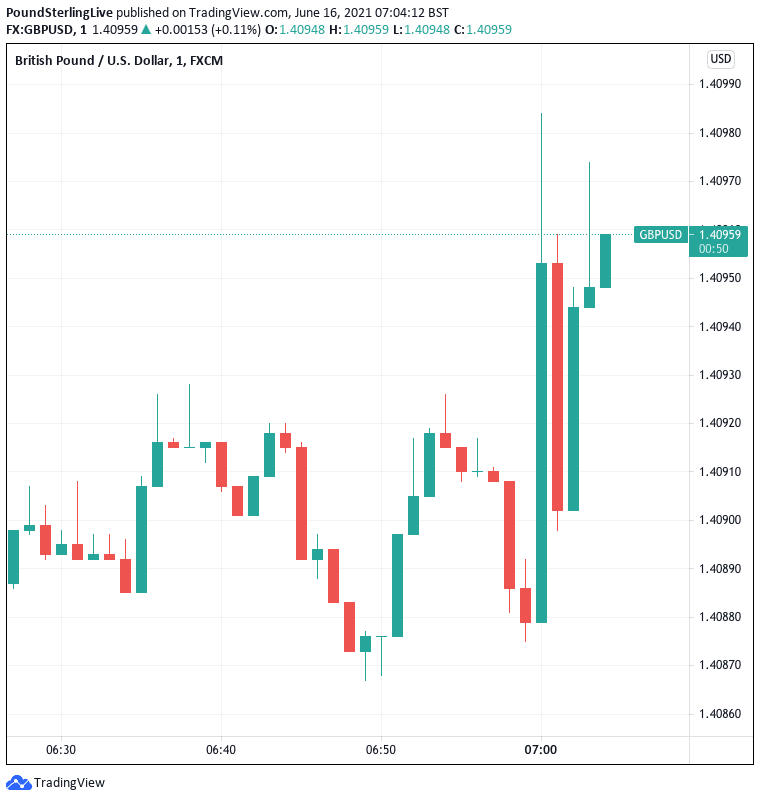Pound Sterling, Euro and Dollar Today: UK Inflation + Federal Reserve in Focus
- Written by: Gary Howes
-
- UK inflation sails past Bank of England target
- GBP rises against EUR and USD
- Investors hope the Fed can ignite FX markets
- GBP, EUR can lift if Fed is dovish says CBA

- Market rates at publication: GBP/EUR: 1.1624 | GBP/USD: 1.4100
- Bank transfer rates: 1.1400 | 1.3800
- Specialist transfer rates: 1.1544 | 1.3910
- Get a bank-beating exchange rate quote, here
- Set an exchange rate alert, here
The British Pound advanced against the Euro, Dollar and other major currencies mid-week following the release of hotter-than-expected UK inflation numbers, but the key focus for FX markets remains tonight's Federal Reserve event which could trigger more durable moves in a market that has been grasping for direction.
The ONS reported UK inflation was higher than investors had expected in May, with the headline month-on-month change reading at 0.6% and the year-on-year rate rising to 2.1%.
This means inflation is now above the Bank of England's 2.0% target and should it remain around current levels the pressure on policy makers to raise interest rates will likely build.
The market had expected the monthly figure to read at a mere 0.3% while the annual figure was forecast at 1.8%, confirming this consensus-beating set of data to be supportive of Sterling exchange rates.
The May readings compare to the April outturn of 0.6% month-on-month and 1.5% year-on-year.
Following the release of the data there was a notable bid in the Pound: the Pound-to-Euro exchange rate rose to 1.1625, the Pound-to-Dollar exchange rate rose to 1.41.
Above: GBP rises in the wake of the release of inflation data.
Secure a retail exchange rate that is between 3-5% stronger than offered by leading banks, learn more.
"Beyond the near term, however, a potential pricing in of higher inflation in forecasts could help consolidate expectations for an initial bank rate hike already next year, that would aid an appreciation of the pound against both the dollar and the euro," says Asmara Jamaleh, Economist at Intesa Sanpaolo.
The current expectation amongst economists - and the Bank of England (BoE) for that matter - is that the spike in inflation currently being seen in the UK and across the world will be temporary as the Covid crisis has created significant distortions in the global economy that will take time to ease.
Based on this assumption the BoE has maintained a view that pressure to raise interest rates in order to cool price rises will be limited and therefore interest rates can remain 'lower for longer'.
But, the ONS said core inflation - which strips out external factors - rose to 2.0% year-on-year in May, blowing past the 1.5% markets had expected.
In fact all measures of inflation beat expectations with PPI Input rising 10.7% year-on-year in May.
"Much of the inflation that is coming through is bad inflation and hitting lower income households in the pocket. How long these price rises continue remains to be seen," says Paul Craig, portfolio manager at Quilter Investors.
"“The data we are getting continues to be noisy and won’t return to normal for some time. Therefore, don’t be surprised to see things run hot for a period while the BoE assesses the impact. For investors they will need to keep listening closely to the noises coming out of the central banks because as soon as they hint at moving, markets will react quickly," adds Craig.
Inflation might become more embedded if wage increases continue apace, as revealed in Tuesday's labour market report, although economists believe this pressure will ease over coming months as furlough is ended.
For those watching currency markets, the bottom line is the UK economy is finding its feet again and this should maintain demand for the Pound.
"With the economy still on secure ground, the market remains confident in GBP despite the setback that concerns over the Delta variant could otherwise have," says Charles Porter, a foreign exchange analyst at SGM Foreign Exchange Ltd.
The UK government on Monday announced they were slowing the country's exit from all lockdown restrictions by a month citing rising Covid infections, delaying the economy's return to full potential.
However economists say the majority of the unlocking has already been achieved and this should ensure strong growth rates are maintained, even if the recovery is slowed somewhat by the decision.
As such, foreign exchange strategists remain relatively sanguine concerning the impact of the delay on the Pound.
"We are maintaining our bullish view for the pound in the belief that the economic outlook over the near-term will trump certain near-term risks that have emerged," says Lee Hardman, Currency Analyst at MUFG.
MUFG do not see the modest delay in the full release from lockdown on 21st June as having a meaningful negative impact for BoE monetary policy and the Pound.
{wbamp-hide start}{wbamp-hide end}{wbamp-show start}{wbamp-show end}
Beyond the Pound, foreign exchange markets are generally respecting recent ranges with little excitement in evidence right across the spectrum.
One reason for this apparent stalemate rests with the looming policy decision from the Federal Reserve (Fed), due out at 19:00 BST.
The Dollar will potentially move in the wake of the decision and this could ignite volatility right across the foreign exchange market.
Ahead of the decision the U.S. currency was seen strengthening against its peers.
"The U.S. dollar rose as Fed officials gathered for a two-day rate meeting. The dollar gained and against the euro and yen, and jumped to one-month peaks versus peers from Britain and Canada," says Joe Manimbo, Senior Market Analyst at Western Union.
The Fed is expected to release a statement as well as new forecasts for the economy and interest rates.
"EUR/USD and GBP/USD are slightly higher ahead of the FOMC. Both currenciescan lift today if the FOMC is dovish as we expect," says Joseph Capurso, Head of International Economics at Commonwealth Bank of Australia.
The new forecasts on where members of the FOMC see interest rate levels in coming months will be of particular interest to a market obsessing about when that first interest rate rise will come.
"The buck could struggle if the Fed sticks to its low rates for longer outlook. However, any material change in the outlook for interest rates that pencils in a sooner rate increase could support the dollar," says Manimbo.
"USD is steady ahead of today’s FOMC meeting," says Capurso. "A key focus for participants is if a majority of FOMC members bring forward the start of the tightening cycle to 2023."
Foreign exchange strategists at Morgan Stanley tell clients they continue to expect a grind higher in the broad USD over the coming months.
Economists at the Wall Street bank expect the Fed to raise forecasts for interest rate levels in coming years and maintain a momentum toward tapering (ending the current quantitative easing programme).
They say this expectation is modestly more hawkish than markets expect, "and consistent with our expectation for USD strength".

